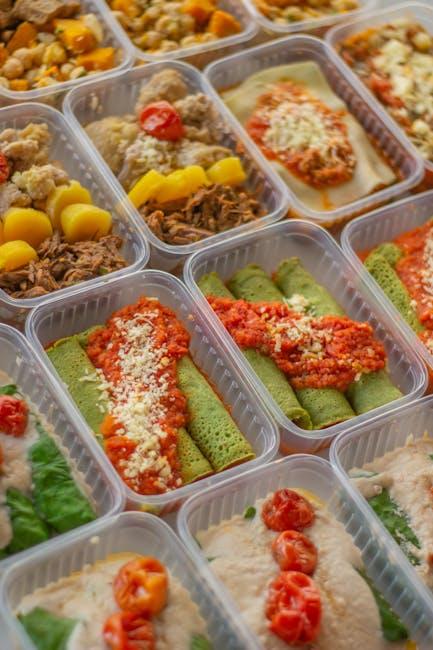Embarking on the GAPS Diet can feel like stepping into a whole new culinary world—especially when you reach Stage 1, where healing begins with the gentlest of foods. This initial phase is all about nurturing your gut with simple, soothing meals that support digestion and reduce inflammation. Crafting a thoughtful meal plan for GAPS Diet Stage 1 not only provides structure during this delicate time but also empowers you to take control of your wellness journey, one bite at a time. In this article, we’ll explore how to build a balanced and nourishing meal plan that honors the unique demands of this healing stage, setting the foundation for renewed health and vitality.
Table of Contents
- Introduction to the Foundations of GAPS Diet Stage 1
- Key Nutritional Components for Healing and Restoration
- Essential Foods to Include and Avoid in Early Recovery
- Sample Daily Meal Plan with Practical Recipe Ideas
- Tips for Monitoring Progress and Adjusting Your Meal Plan
- Q&A
- In Retrospect

Introduction to the Foundations of GAPS Diet Stage 1
The initial phase of the GAPS Diet is designed to gently reset the digestive system by introducing foods that are both nourishing and easy to digest. This stage emphasizes nutrient-dense, homemade broths, fermented foods, and plain, cooked vegetables that soothe the gut lining and help eliminate toxins. Focusing on these foundational elements ensures that the body receives optimal support while reducing inflammation and promoting healing. Incorporating simple protein sources like eggs and fish also provides essential amino acids without overwhelming the digestive tract.
Success in this stage relies on carefully selected foods and mindful preparation techniques. Some of the staples include:
- Homemade bone broth: Rich in gelatin and minerals that rebuild the gut lining.
- Fermented vegetables: Provide beneficial probiotics for digestive balance.
- Steamed or sautéed non-starchy vegetables: Such as zucchini and spinach for gentle fiber intake.
- Raw organic eggs: Ideally pasture-raised, for high-quality protein and nutrients.
| Food Group | Recommended Items | Preparation Tips |
|---|---|---|
| Broths | Chicken, beef, fish bone broth | Simmer for 12–24 hours to extract nutrients |
| Vegetables | Zucchini, carrots, spinach | Lightly steamed or sautéed in animal fat |
| Proteins | Egg yolks, soft-cooked fish | Use organic, avoid frying |
| Fermented Foods | Homemade sauerkraut, kefir | Start with small servings to gauge tolerance |
Key Nutritional Components for Healing and Restoration
To support the delicate process of gut healing during the initial phase of the GAPS diet, focus on incorporating foods rich in collagen and gelatin. These proteins are crucial for restoring the intestinal lining, reducing inflammation, and enhancing digestion. Bone broth is the ultimate superstar here, providing not only collagen but also key minerals like calcium, magnesium, and phosphorus that further aid cellular repair. Additionally, fermented foods introduce beneficial probiotics, which help rebalance gut flora and strengthen the immune system. Prioritize well-cooked vegetables and gently prepared meats, as these are easier for the digestive system to handle in this fragile stage.
Vitamins and minerals also play a starring role in tissue repair and overall recovery. Emphasize foods rich in vitamin A, such as liver and cooked egg yolks, for their antioxidant properties and ability to support mucosal health. Vitamin C, found in small amounts in homemade meat stocks and fermented vegetables, boosts collagen synthesis and fights oxidative stress. Zinc, essential for immune function, can be found in quality meats and seafood included in the GAPS stage 1 meal plan. Below is a quick reference of key nutrients and their sources to guide your meal planning:
| Nutrient | Primary Sources | Role in Healing |
|---|---|---|
| Collagen & Gelatin | Bone broth, gelatin from homemade stock | Repairs intestinal lining, reduces inflammation |
| Vitamin A | Liver, egg yolks | Supports mucosal health, antioxidant |
| Vitamin C | Fermented vegetables, meat stock | Enhances collagen synthesis, antioxidant |
| Zinc | Meats, oysters | Immune function, tissue repair |
Essential Foods to Include and Avoid in Early Recovery
During the initial phase of recovery, focus on nourishing your body with nutrient-dense, easily digestible foods that promote healing and gut repair. Bone broth is a cornerstone, packed with collagen and minerals that help restore gut lining integrity. Incorporate gently cooked vegetables like zucchini and carrots, and introduce homemade probiotic foods such as sauerkraut juice or kefir sparingly to support beneficial gut flora. Protein sources should be tender and simple — think of slow-cooked meats or eggs — to provide essential amino acids without overwhelming your digestive system.
Conversely, it’s vital to steer clear of foods that can aggravate inflammation or disrupt gut balance. Avoid grains, refined sugars, and starchy tubers since they may feed harmful bacteria and delay recovery. Also, steer clear of processed foods, artificial additives, and raw vegetables which might be too harsh on sensitive digestive tracts during this stage. Below is a simple breakdown to clarify recommended and discouraged foods for smoother progress:
| Recommended | Avoid |
|---|---|
| Homemade bone broth | Grains and cereals |
| Slow-cooked meats and eggs | Refined sugars |
| Gentle cooked vegetables (zucchini, carrots) | Raw vegetables |
| Homemade fermented juices (sauerkraut juice, kefir) | Processed foods and additives |
Sample Daily Meal Plan with Practical Recipe Ideas
Morning: Begin your day with a soothing bone broth rich in collagen and minerals, perfect for healing the gut lining. Accompany this with a lightly cooked vegetable such as steamed zucchini or carrots, lightly seasoned with fresh herbs. For a practical twist, try simmering the broth with a handful of fennel seeds or ginger to add warmth and improve digestion.
Midday & Evening: Focus on nutrient-dense, easy-to-digest meals such as gently cooked organic chicken or fish, combined with fermented vegetables like sauerkraut to introduce beneficial probiotics. Here’s a simple table of ideas to mix and match:
| Protein | Vegetables | Flavor Enhancers |
|---|---|---|
| Steamed chicken breast | Sautéed spinach | Fresh thyme |
| Poached white fish | Steamed zucchini | Ginger slices |
| Eggs (soft boiled) | Fermented sauerkraut | A dash of lemon juice |
- Snack idea: Small portions of homemade probiotic yogurt (if dairy is tolerated) or a cup of warm herbal tea.
- Hydration tip: Sip on mineral-rich water or bone broth throughout the day to support digestive health.
Tips for Monitoring Progress and Adjusting Your Meal Plan
Tracking how your body reacts day by day is essential for success. Incorporate a simple journal or digital spreadsheet where you can note symptoms, energy levels, and digestion. This allows you to recognize patterns, making it easier to identify which foods are supportive and which may cause setbacks. Pay special attention to subtle changes in mood and sleep quality, as these can often be clues to how well your gut is healing.
Adjustments should be gradual and thoughtful. Use the following guide to tweak your meal plan based on progress:
- If feeling strong and symptom-free: Introduce small portions of new GAPS-friendly foods concurrently with removing more restrictive items.
- If symptoms flare up: Temporarily revert to more restrictive foods and simplify meals to ease your gut.
- Regularly review hydration and nutrient variety: Ensure your meal plan includes plenty of homemade broths, fermented foods, and fresh vegetables aligned with stage 1 allowances.
| Progress Indicator | Recommended Action |
|---|---|
| Improved digestion & energy | Gradually add new GAPS-approved foods |
| Recurrent bloating or discomfort | Simplify meals, revisit broths and fermented foods |
| Stable sleep & mood | Maintain current meal structure, consider adding variety |
Q&A
Q&A: Navigating Meal Plans for GAPS Diet Stage 1
Q1: What exactly is the GAPS Diet Stage 1?
A1: The GAPS Diet Stage 1 is the initial phase of the Gut and Psychology Syndrome (GAPS) diet designed to heal and seal the gut lining. It focuses on easily digestible, nutrient-dense foods to soothe the digestive system and reduce inflammation.
Q2: Why is meal planning important in Stage 1 of the GAPS Diet?
A2: Meal planning ensures consistent intake of gut-friendly foods that support healing while avoiding potentially irritating ingredients. It also helps manage symptoms by simplifying food choices during this sensitive phase.
Q3: What foods are typically included in a Stage 1 GAPS meal plan?
A3: Core foods include homemade meat or fish stocks, slow-cooked meats, non-starchy vegetables like zucchini and carrots, fermented foods such as sauerkraut, and probiotic-rich beverages like homemade yogurt or kefir.
Q4: Are there any foods that should be strictly avoided in Stage 1?
A4: Yes, all grains, refined sugars, starches, and processed foods are off-limits. Dairy is only introduced later unless tolerated as fermented forms. Raw vegetables and fibrous plants are initially avoided to prevent gut irritation.
Q5: How are meals typically structured during Stage 1?
A5: Meals revolve around broths and soups infused with natural fats and proteins, often eaten multiple times a day in small portions. This approach aids in digestion and gradual gut restoration.
Q6: Can people with dietary restrictions or preferences follow Stage 1 of the GAPS diet?
A6: The diet is quite specific, but with creativity, substitutions can be made. For example, alternative protein sources like fish or poultry can replace red meat. It’s best to consult a healthcare professional to tailor the plan safely.
Q7: How long does one usually stay in Stage 1?
A7: Duration varies based on individual response but typically lasts 2 to 6 weeks. Progression depends on symptom improvement and gut healing, after which more foods are cautiously reintroduced.
Q8: What are some practical tips for success with Stage 1 meal planning?
A8: Prepare stocks and broths in advance, keep meals simple, and focus on nutrient density. Listening to your body’s signals and journaling food reactions can help fine-tune the plan for optimal healing.
Q9: Is it necessary to take supplements during Stage 1?
A9: Supplements aren’t mandatory but may support healing. Common additions include probiotics, omega-3 fatty acids, and digestive enzymes, preferably under professional guidance.
Q10: How does Stage 1 meal planning support long-term gut health?
A10: By establishing a foundation of gut-soothing, anti-inflammatory foods, Stage 1 sets the stage for rebuilding a balanced microbiome and improved nutrient absorption, crucial for sustained digestive wellness.
In Retrospect
Embarking on the Stage 1 GAPS diet meal plan is more than just a dietary adjustment—it’s a mindful step toward nurturing your gut and reclaiming well-being. While this initial phase may feel restrictive, it lays a crucial foundation for healing and transformation. With patience and creativity in the kitchen, you can turn simple ingredients into comforting, nourishing meals that support your journey. Remember, every broth sipped and every carefully chosen bite brings you closer to renewed health and balance. As you progress, let this stage be a reminder that healing is a process—one meal at a time.

